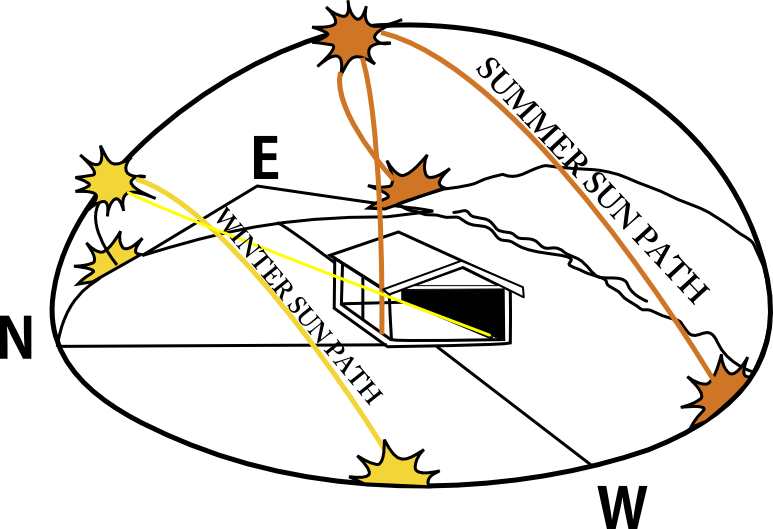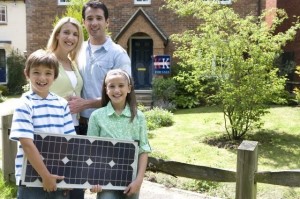Avoid being stung by inexperienced solar panel installers by understanding the process, prices, and companies with Australian Solar Quotes. Our website has helped over twenty thousand home owners switch to solar energy by connecting them with local solar energy companies and educating them with the basics about solar energy.
Solar energy matters and to get the most out of your solar power system, there are a few simple guidelines that you can stick by. Most importantly, you can access the maximum solar gain by having the solar panels installed by a professional solar company that has been rated and reviews on our website and holds Clean Energy Council accreditation.
Once you have completed our short solar quote form, you can start to get familiar with the topic by reading through our home solar buyer’s guide.

Install the solar energy panels on a northern facing roof
The sun rises from the east and sets in the west, although regular tracking of the sun shows that the position shifts towards the north of the sky in the middle of the day. During this time, the sun is closest to earth and combining these two factors makes north the optimal direction for you panels to face to maximise your solar gain.

Every bit of solar energy matters
This is one way to look at it however if you are an economic conservative like me then you need to take into account the cost verses the return on investment. For example, if the roof that you want to install the solar panels on is facing north east, do you need to install a special frame so that the panels are facing north? My answer to that question is no and for a couple of reasons.
Firstly, your solar power system will only produce an additional 3 to 5 percent more solar energy if the panels are facing north. In my opinion, this is a small loss and not justifiable when you way up the cost of a more complex installation. Secondly, custom roof top solar panel frames that do not sit flush along the roof are not as aesthetically pleasing compared to standard installations. Finally, anything that is outside the scope of ‘standard practice’ can potentially cause more problems both during installation and maintenance.
This being said, it is not uncommon to have the solar energy panels installed on the east or west facing sides of your home. Although the solar gain is lower, the directional losses are not that great.
- The solar panel directional losses for north-east and north-west vary from around 3% to 4%.
- For an east or west facing roof, your solar gain loss will be around 12% to 18%
When you get 3 quotes through our website, you will be connected with an experienced solar installer or sales rep who will be able to work out the optimum solar panel direction and angle on your property. With this information, you can make an informed decision on where to install the solar panels to get the highest solar gains and the best return on investment.
So if the sales rep recommends installing the solar power system on the east or west facing front, then don’t be too alarmed and ask for a solar energy gain comparison or use our online solar power calculator.
Although not essential, it is advised that you ask for a plan or design for your solar power system. The rough design should outline the installation options and the exact location where the solar panels will be placed. Most solar companies will ask that you sign off on the plan prior to the installation of the solar energy system. This ensures that both parties are aware and agree to location for the rooftop solar panels to be installed.
If the sales rep or solar panel installer recommends that you install the panels on the south facing roof then you should start to ask questions. Perhaps you can start with: “What hemisphere are we on?”
When you get 3 solar panel quotes through our website though, you will only be connected with top quality solar energy companies that have been rated and reviewed by home owners in your area.
We have over ten thousand solar company reviews spread out over five thousand Australian suburbs and towns.

When do solar power systems work?
The amount of solar energy that is generated from a solar power system is higher in the middle of the day when the sun’s position is high up in the sky.
The panels start to generate solar energy as soon as the sunlight hits them in the morning and stops producing solar energy when the sun goes down in the late afternoon.
When the sun begins to move in a northerly direction, normally around 9am, your solar energy production will begin to increase experientially though. This is when your solar power system will produce the bulk of the energy throughout the day.
During winter, the solar gain may not begin to increase until 10am or even later.
Other variable factors that play an important role in the daily solar gain include:
The direction that the solar panels are facing
Solar panels are activated when they are exposed to sunlight and deactivated in its absence
Solar panels that are installed on an eastern facing roof are more optimised to absorb sunlight throughout the morning as the sun rises and moves towards the middle of the sky. As the sun starts to set in the west, the eastern facing panels are not exposed to the sunlight, therefore the system will not produce electricity. This is reversed for panels which are installed on a western facing roof. The ideal direction for solar panels in Australia is north.
Multiple facing solar panel arrays
If you have multiple solar panel arrays, then the solar energy will activate at different times of the day
With residential solar installations, it’s not uncommon to have a lack of roof space for the optimal solar panel installation. You may find that you have enough room on the northern facing roof to fit eight solar panels and room for an additional eight panels on the western facing roof. If this is the case, then you will need to either install an inverter that has build in ‘dual MPPT‘ or install solar panels that come with built in micro-inverters.
To read more about inverters, micro-inverters and functionality, check out the solar inverters page.
With this particular installation, your solar power system should fire up around 9am and continue to produce power until late hours of the afternoon.
If you have multiple arrays, then the solar gain will differ. Keeping this in mind, it is important to look at the two solar arrays individually. Each of them will experience different directional losses depending on the pitch of the roof, the direction that the solar energy panels are facing, and the voltage of the panels.
Your location in Australia
Your properties geographical location plays a large part in the activation of your solar panels
Location plays an important role with the production of solar energy. The position on the planet determines the exposure and intensity of the suns ultraviolet rays. The further north you are the more solar energy your panels will produce.

The graph illustrates the performance of a 5.0kW PV system in the middle of summer in Townsville, North Queensland.
What size solar power system is right for you
The size of the solar power system for your home depends on what you are trying to achieve.
Do you want to eliminate your electricity bill by producing the maximum amount of solar energy that is possible or are you looking to capitalise from your investment with the solar feed-in tariff?
- How much optimal roof space do you have?
- What size system have you been approved to install by your energy retailer?
- Does the size of your desired system comply with the state government feed-in tariff criteria?
- How deep are your pockets? (The cost to go solar)
- And finally, would you like to reduce your power bill? Wipe out your power bill completely? Or get a generous cheque in the mail each year?
Keep in mind, solar panel sizes vary in wattage. You can get panels that produce 170 Watts or panels that produce 250 Watts plus. So keep an eye on the total system wattage, not the amount of panels.


To get the right solar power system size and design, you will generally need an on-site assessment to establish how many solar panels you will need. Most Australian solar companies will initially arrange for their accredited solar installer or experienced sales representative to call you, so that they can gather information about your property and from there, provide you with an accurate home assessment and quote for costs.
To initialise this process, all you need to do is complete our short online form. We will put you in touch with local solar professionals in your area who can arrange a free home assessment.
Be sure to have your current electricity bill handy when the sales representative of solar panel installer visits. This will initiate discussion, tips and solutions for your household energy consumption. The energy bill will also assist them in determining which plan you have in place with your electrical retailer.